Clothes elevator: Difference between revisions
more pics |
No edit summary |
||
| (14 intermediate revisions by 2 users not shown) | |||
| Line 1: | Line 1: | ||
I | [[File:Final use.jpg|thumb|''by Adam Wight, 2024'']] | ||
I was surprised to find that Berlin working-class life doesn't typically include luxuries such as an electric clothes dryer. The washers, dryers and laundromats I have known were always beloved, but only more so in their absence. | |||
The mischief one gets up to without a dryer strains the imagination. Strings, fans, hidden rooms; carting sodden rags; dry cleaning… | |||
What follows is a story of one such adaptation. | |||
<div style="clear: both;"></div> | |||
== Pulleys: how does that work? == | |||
[[File:Logs.jpg|left|thumb|200x200px]] | [[File:Logs.jpg|left|thumb|200x200px|Logs which will become pulleys]] | ||
[[File:Marked log.jpg|thumb|200x200px]] | [[File:Marked log.jpg|thumb|200x200px|Log on a spinning lathe, turned round and with widths penciled on]] | ||
[[File: | [[File:Lathe learning.jpg|left|thumb|200x200px|The lips are too fragile for this beginner]] | ||
[[File: | [[File:Stack of pulleys.jpg|thumb|301x301px|Eventual progress]] | ||
Like any sincerely amateur hobbyist, I started with the funnest part: pulleys. Through window shopping I saw that pulleys would add up to at least a hundred bucks, so I decided to buy a wood lathe for 200 instead, and learn how to turn the pulley rollers.<ref>If you're reading for lathe tips, I enjoyed Frank Pain's book "Practical Woodturner". If you haven't looked into woodturning, its demonstration videos are a genre rich with great content and eccentric narrators.</ref> I lack a shop at the moment so I "rent" storage under a basement table and awkwardly carry the machine upstairs in its deteriorating styrofoam box. First world problems, you could say. But after making the first few into firewood, my pulleys eventually came out okay! | |||
Mechanical engineering is not my thing, which is unfortunate because I enjoy making stuff that is used and should not fall apart. In my trail of destruction lie bendable garden tools, fallen shelves, and bicycle trailers tipping their loads in the rain and at night. I once tried to find myself an evening continuing ed. class on engineering, but to my surprise this isn't how it works—nobody wants their city's bridge designed by a punter who picked up their math on odd nights out and a couple of video explainers. | |||
Aluminum angle for the runners and aluminum<ref>Weird side note: different types of metal touching one another do a molecular-electrical [[w:Galvanic_corrosion|Galvanic corrosion]] thing over time.</ref> pop rivets | But still, I blame elitism. | ||
[[File:Plywood pulley w slash.jpg|thumb|150x150px]] | |||
Mounting the pulleys had me at a loss for bad ideas. Here's one example, a monstrosity of scrap plywood. It's cute that the pulley is invisible, but there's nothing else good happening here. | For this reason and other factors, it's taken me a few years to build up the courage to try a clothes elevator. The problem seemed unattainably mathy at first, full of various angles and lengths... the idea stagnated and each time I sketched it, it came out obviously wrong and incomplete. | ||
[[File:All pulleys.jpg|thumb|203x203px]] | |||
[[File:Thread lock.jpg|left|thumb|200x200px | The turning point came once it was clear that a fixed pulley simply changes the direction of force, and this direction can be either constrained and dynamic, or constant. I like constant. | ||
Bending whatever metal strapping around the pulleys is fine and leaves me free to use any type of bolt appropriate for the mysterious ceiling. The axle should have been simple, let's not discuss how overcomplicated I made this | In other words, the rope's travel is equal but opposite as seen from either side of a pulley. If the pulleys stay put it gets even simpler, and all that's happening in my case is that downwards pulling force on a rope is rotated by 90° at the ceiling, and then another 90° so that it's acting upwards on the load. This is just the fancy equivalent of a 180° turn over a single pulley [img]! | ||
[[File:Hatch open.jpg|left|thumb|150x150px]] | |||
[[File:Hatch.jpg|thumb|150x150px]] | <div style="clear: both;"></div> | ||
== A second-best bed == | |||
[[File:Raw bed.jpg|left|thumb|200x200px|Sideways bed on the street is suddenly looking good]] | |||
[[File:Bed remnants.jpg|thumb|400x400px|After a few days, bones are picked clean to bleach in the rain]] | |||
Another year or two passes. But one afternoon I stumbled across a huge oak bed on the street. Having spent my youth observing city trash floes, I recognized this for the incredibly attractive nuisance it is and I rushed home to get the tools to dismantle it. Indeed, by the time I returned, scavengers or vandals had already chewed or stomped a dozen of the sticks out and... I'm really curious to know what the missing, jagged stumps could have been used for? Anyway, it's cold and dark out by this time, and I'm doing something of ambiguous legality and ethicality in a public place, let's not sweat the small things. I unscrewed the sticks that remained, tossed them into an innocuous getaway stroller and walked back home, hunched over my prize. | |||
The slats were perfect: hardwood at roughly 2.5cm x 1cm x 1.0m. Beveling the business edges and sanding to 180 grit or so leaves the wood smooth enough for cloth to slide over, but rough enough to not slip. (I forgot to sand the slats before assembly and it became unwieldy afterwards. Hopefully dear reader you will remember if the time comes.) | |||
== Tie it together == | |||
Aluminum angle serve admirably for the runners, and aluminum<ref>Weird side note: different types of metal touching one another do a molecular-electrical [[w:Galvanic_corrosion|Galvanic corrosion]] thing over time.</ref> pop rivets holding slats to the runners keep the overall weight down.[weigh it] | |||
[[File:Plywood pulley w slash.jpg|thumb|150x150px|Don’t ask. Rope is definitely not running off the wheel in this encarcelation!]] | |||
Mounting the pulleys however had me at a loss for bad ideas. Here's one example, a monstrosity of scrap plywood. It's cute that the pulley is invisible, but there's nothing else good happening here. | |||
<div style="clear: both;"></div> | |||
[[File:All pulleys.jpg|thumb|203x203px|Generic brackets made of whatever]] | |||
[[File:Thread lock.jpg|left|thumb|200x200px|Please apply thread lock if you choose to use bolts]] | |||
Bending whatever metal strapping around the pulleys is fine and leaves me free to use any type of bolt appropriate for the mysterious ceiling. The axle should have been simple, let's not discuss how overcomplicated I made this out of a misplaced urge to use up old junk. Just a safety note that if you too choose to hang anything unusual above your head, please make sure that it can't loosen with time. | |||
<div style="clear: both;"></div> | |||
[[File:Bracket closeup.jpg|thumb|268x268px|Rope’s eye view. Fits any type of anchor bolt.]] | |||
[[File:Hatch open.jpg|left|thumb|150x150px|Lucky access hatch ]] | |||
[[File:Hatch.jpg|left|thumb|150x150px|The hatch door sporting a few new screwholes]] | |||
By a stroke of luck, I found that the bathroom ceiling included a few metal studs, which I trust to give hints before catastrophic failure, unlike the ancient concrete and plaster powder everywhere else in the apartment. And even luckier, a strange little access door provides a clutch of extra metal to anchor to, all in the spot directly above a door jamb where I planned to anchor to anyway. If you don't have a little door like this, it will provide insight, it's low risk—and you might lure a family of Borrowers. | By a stroke of luck, I found that the bathroom ceiling included a few metal studs, which I trust to give hints before catastrophic failure, unlike the ancient concrete and plaster powder everywhere else in the apartment. And even luckier, a strange little access door provides a clutch of extra metal to anchor to, all in the spot directly above a door jamb where I planned to anchor to anyway. If you don't have a little door like this, it will provide insight, it's low risk—and you might lure a family of Borrowers. | ||
[[File:Halogen spotlight.jpg|thumb|150x150px]] | |||
[[File:Led flood.jpg|thumb|164x164px]] | <div style="clear: both;"></div> | ||
== Sombras, nada mas == | |||
[[File:Halogen spotlight.jpg|left|thumb|150x150px|Halogen spotlight, ca. 1990]] | |||
[[File:Led flood.jpg|thumb|164x164px|LED floodlight moving in like a hermit crab]] | |||
The ceiling lights became a subproject: old halogen bulbs burn out too quickly to keep lit, and their spotlight focus never illuminated much to begin with. Random LED flood bulbs can be found having the same socket, but the overall radius was much wider. Luckily, the design lent itself to a bent bit of telegraph wire: it was possible to make clips that hold the new bulbs in place after throwing out a few of the landlord's light parts. These flood bulbs also seem to cast better light by reflecting off of the walls to get around the humungous new obstruction, whereas spots would have been blocked by the rack and clothes. | |||
<div style="clear: both;"></div> | |||
== Results == | |||
[[File:Rack at top.jpg|thumb]] | [[File:Rack at top.jpg|thumb]] | ||
[[File:Rope routing.jpg|left|thumb]] | [[File:Rope routing.jpg|left|thumb]] | ||
This | This one is 1x3m and fits three or so loads of laundry. Which is great, except that when full it can add up to much more weight than is comfortable to lift. | ||
The | A block and tackle system was straightforward to make from two pairs of double pulleys, which I boringly purchased at the big box like it is the waning tail of the Industrial Age, and provides something between a 3:1 and 5:1 advantage.<ref>The jury is still out on this. Eyeballing it suggests a 5:1 ratio, but there's still much I don't understand. When I put a luggage scale on the ropes, it reads a 30kg pull before the multiple pulleys, and a 10kg pull for the operator, which is unignorably close to an exact 3:1 ratio.</ref> This part of the junk needs to run smoothly and be unlikely to explode, so I have no regrets about my retreat. | ||
Finally, my reward is that local children will enthusiastically run the winches while singing "Scrub, Scrub".<ref>Link withheld to protect the innocent.</ref> | |||
<div style="clear: both;"></div> | |||
'''Notes''' | '''Notes''' | ||
<references /> | <references /> | ||
__NOTOC__ | |||
Latest revision as of 20:56, 13 April 2024

I was surprised to find that Berlin working-class life doesn't typically include luxuries such as an electric clothes dryer. The washers, dryers and laundromats I have known were always beloved, but only more so in their absence.
The mischief one gets up to without a dryer strains the imagination. Strings, fans, hidden rooms; carting sodden rags; dry cleaning…
What follows is a story of one such adaptation.
Pulleys: how does that work?
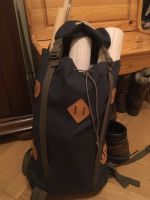
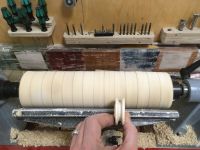

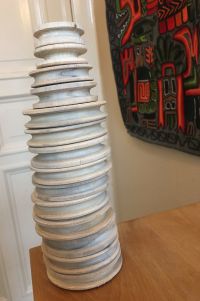
Like any sincerely amateur hobbyist, I started with the funnest part: pulleys. Through window shopping I saw that pulleys would add up to at least a hundred bucks, so I decided to buy a wood lathe for 200 instead, and learn how to turn the pulley rollers.[1] I lack a shop at the moment so I "rent" storage under a basement table and awkwardly carry the machine upstairs in its deteriorating styrofoam box. First world problems, you could say. But after making the first few into firewood, my pulleys eventually came out okay!
Mechanical engineering is not my thing, which is unfortunate because I enjoy making stuff that is used and should not fall apart. In my trail of destruction lie bendable garden tools, fallen shelves, and bicycle trailers tipping their loads in the rain and at night. I once tried to find myself an evening continuing ed. class on engineering, but to my surprise this isn't how it works—nobody wants their city's bridge designed by a punter who picked up their math on odd nights out and a couple of video explainers.
But still, I blame elitism.
For this reason and other factors, it's taken me a few years to build up the courage to try a clothes elevator. The problem seemed unattainably mathy at first, full of various angles and lengths... the idea stagnated and each time I sketched it, it came out obviously wrong and incomplete.
The turning point came once it was clear that a fixed pulley simply changes the direction of force, and this direction can be either constrained and dynamic, or constant. I like constant.
In other words, the rope's travel is equal but opposite as seen from either side of a pulley. If the pulleys stay put it gets even simpler, and all that's happening in my case is that downwards pulling force on a rope is rotated by 90° at the ceiling, and then another 90° so that it's acting upwards on the load. This is just the fancy equivalent of a 180° turn over a single pulley [img]!
A second-best bed
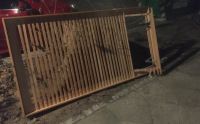

Another year or two passes. But one afternoon I stumbled across a huge oak bed on the street. Having spent my youth observing city trash floes, I recognized this for the incredibly attractive nuisance it is and I rushed home to get the tools to dismantle it. Indeed, by the time I returned, scavengers or vandals had already chewed or stomped a dozen of the sticks out and... I'm really curious to know what the missing, jagged stumps could have been used for? Anyway, it's cold and dark out by this time, and I'm doing something of ambiguous legality and ethicality in a public place, let's not sweat the small things. I unscrewed the sticks that remained, tossed them into an innocuous getaway stroller and walked back home, hunched over my prize.
The slats were perfect: hardwood at roughly 2.5cm x 1cm x 1.0m. Beveling the business edges and sanding to 180 grit or so leaves the wood smooth enough for cloth to slide over, but rough enough to not slip. (I forgot to sand the slats before assembly and it became unwieldy afterwards. Hopefully dear reader you will remember if the time comes.)
Tie it together
Aluminum angle serve admirably for the runners, and aluminum[2] pop rivets holding slats to the runners keep the overall weight down.[weigh it]
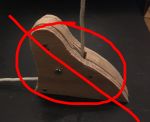
Mounting the pulleys however had me at a loss for bad ideas. Here's one example, a monstrosity of scrap plywood. It's cute that the pulley is invisible, but there's nothing else good happening here.
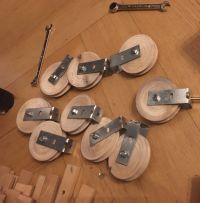

Bending whatever metal strapping around the pulleys is fine and leaves me free to use any type of bolt appropriate for the mysterious ceiling. The axle should have been simple, let's not discuss how overcomplicated I made this out of a misplaced urge to use up old junk. Just a safety note that if you too choose to hang anything unusual above your head, please make sure that it can't loosen with time.
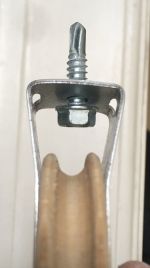
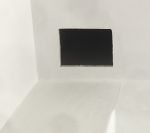

By a stroke of luck, I found that the bathroom ceiling included a few metal studs, which I trust to give hints before catastrophic failure, unlike the ancient concrete and plaster powder everywhere else in the apartment. And even luckier, a strange little access door provides a clutch of extra metal to anchor to, all in the spot directly above a door jamb where I planned to anchor to anyway. If you don't have a little door like this, it will provide insight, it's low risk—and you might lure a family of Borrowers.
Sombras, nada mas

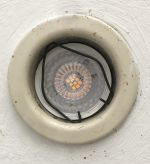
The ceiling lights became a subproject: old halogen bulbs burn out too quickly to keep lit, and their spotlight focus never illuminated much to begin with. Random LED flood bulbs can be found having the same socket, but the overall radius was much wider. Luckily, the design lent itself to a bent bit of telegraph wire: it was possible to make clips that hold the new bulbs in place after throwing out a few of the landlord's light parts. These flood bulbs also seem to cast better light by reflecting off of the walls to get around the humungous new obstruction, whereas spots would have been blocked by the rack and clothes.
Results

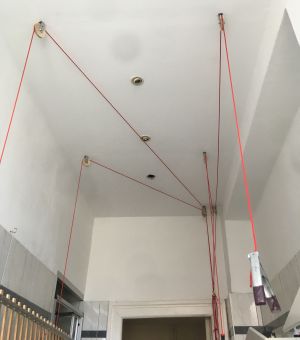
This one is 1x3m and fits three or so loads of laundry. Which is great, except that when full it can add up to much more weight than is comfortable to lift.
A block and tackle system was straightforward to make from two pairs of double pulleys, which I boringly purchased at the big box like it is the waning tail of the Industrial Age, and provides something between a 3:1 and 5:1 advantage.[3] This part of the junk needs to run smoothly and be unlikely to explode, so I have no regrets about my retreat.
Finally, my reward is that local children will enthusiastically run the winches while singing "Scrub, Scrub".[4]
Notes
- ↑ If you're reading for lathe tips, I enjoyed Frank Pain's book "Practical Woodturner". If you haven't looked into woodturning, its demonstration videos are a genre rich with great content and eccentric narrators.
- ↑ Weird side note: different types of metal touching one another do a molecular-electrical Galvanic corrosion thing over time.
- ↑ The jury is still out on this. Eyeballing it suggests a 5:1 ratio, but there's still much I don't understand. When I put a luggage scale on the ropes, it reads a 30kg pull before the multiple pulleys, and a 10kg pull for the operator, which is unignorably close to an exact 3:1 ratio.
- ↑ Link withheld to protect the innocent.
